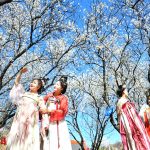
Recently, archaeological experts from the Longmen Grottoes Research Institute found a bust of a Bodhisattva in the Tang Dynasty in the Yihe River, adding new information to the study of the history of the Longmen Grottoes.
The statue was found in the river about 100 meters north of the Longmen Stone Arch Bridge, with the head missing, and the body was cut into two sections from the chest and abdomen. “The statue is cylindrical, plump, muscular, wearing a skirt, with scarves hanging down on both sides of the body, and traces of streamers can be seen.” Lu Wei, director of the History and Humanities Research Center of the Longmen Grottoes Research Institute, said that the statue stands on the rosette, the front half of the rosette has been damaged, and there is a tenon under the seat.
“Recently, the relevant departments will drain the river water in this section of the river, carry out the maintenance of the rubber dam on the water surface and the construction of the cruise ship wharf, and part of the riverbed in the eastern half of the river is exposed, so we will take the opportunity to investigate in the river to see if there are cultural relics.” According to Lu Wei, the river is densely covered with stones, and it is covered with silt and green algae, etc., and the focus of the investigation is to determine whether there are traces of artificial carving on the stones. After the suspected stone was discovered, archaeologists cleaned it up with the help of brushes and shovels, and this treasure left behind in the Longmen Grottoes finally resurfaced.

Archaeologists also carried out a large-scale survey and simple cleaning of the downstream of the Longmen stone arch bridge, and found two remnants in different locations. Among them, one is carved into a larger rock, and the legs and feet of the statue can be distinguished. Because it has been washed by flowing water for a long time and tumbled and collided in the river, the surface decoration of the statue has been damaged, and the carving details have lost their original clarity and delicacy.
Why do cave statues appear in the river? There could be two reasons for this, Lovells explained. First, the ancient Yi River water potential is larger, in the flood season often overflowed the embankment, sometimes will wash away the cave temple on the bank, the Buddha statue and so on into the river, for example, in the tenth year of the Kaiyuan Dynasty, the Longmen section of the Yi River flooded, it washed away the famous royal temple Fengxian Temple in the Tang Dynasty and the nearby Tianzhu Temple. Second, in the first half of the 20th century, the Longmen Grottoes were destroyed by digging rocks and stealing stones, and some Buddha statues fell into the river, and after a long time of erosion, they tumbled downstream.
Lu Wei revealed that over the years, archaeologists have found four cultural relics in the Yihe River. Among them, a round statue of Maitreya was found in 2007, complete below the head, and more than 70 centimeters high; There is also a cultural relic, is a side length of nearly 2 meters on the mountain stone carved with a round arch niche, found in 2012 in the western half of the Yihe River dredging project, carved in the shrine one Buddha two Bodhisattva three statues, the main Buddha seat carved out of the stem lotus seat, for the Tang Dynasty statue niche. These statues provide more abundant information for the study of Longmen Grottoes, and help to deepen the research on the connotation, culture and art, and history of Longmen Grottoes.
“During the Tang Dynasty and Northern Wei Dynasty, the Yihe River bed was much lower than it is now, and after thousands of years of changes, we speculated that there would be cultural relics left in the river, so we carried out relevant investigation work when we found the right opportunity.” In the next step, archaeologists will pay more attention to the works and related dredging projects in the Yihe River channel, and look forward to more new discoveries, Lu said. (Luoyang Daily Financial Media Luoyang Net Reporter Wisdom) (Photo courtesy of Longmen Grottoes Research Institute)








